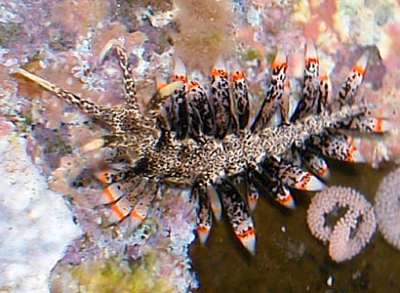
Herviella claror
Burn, 1963
Order: NUDIBRANCHIA
Suborder: AEOLIDINA
Family: Glaucidae
DISTRIBUTION
Known only from eastern Australia [nthn NSW, sthn Qld.]
PHOTO
Alexandra Headland, Mooloolaba, Queensland, Australia. intertidal, Length: 12 mm. 26 Septemeber 2005. Intertidal. Photographer: Gary Cobb
Herviella, is a genus of about ten or so small species of aeolid, usually with black specks and often with a gold or orange band below the ceratal tip. The cerata are arranged in a series of sloping single rows down each side of the body. H. claror is characterised by the colour of the rhinophores - black speckling all over except for a translucent whitish region at the tip. The cerata have black speckling from the subterminal orange band down to the base. It has many similarities in colour to Herviella affinis, but in that species there is a distinct blackish band midway down the rhinophores and the cerata have a wide white region between the subterminal orange band and the black speckling which only occurs in the lower third.
- Baba, K (1960): The genus Herviella and a new species, H. affinis, from Japan (Nudibranchia - Eolidacea). Publications of the Seto Marine Biological Laboratory 8(2, December), 303-305.
- Burn, R F (1963): Descriptions of Australian Eolidacea Mollusca: Opisthobranchia). 1. The genera Catriona and Herviella. Journal of the Malacological Society of Australia, 7(6 December), pp.12-pp.20.
- Burn, R F (1967): Revision of the genus Herviella (Opisthobranchia: Eolidacea). Malacologia 6(1-2), 223-230.
- Rudman, W.B. (1980) Aeolid opisthobranch molluscs (Glaucidae) from the Indian Ocean and the south-west Pacific. Zoological Journal of the Linnean Society, 68(2):139-172.
Rudman, W.B., 2005 (September 27) Herviella claror Burn, 1963. [In] Sea Slug Forum. Australian Museum, Sydney. Available from http://www.seaslugforum.net/find/hervclar
Related messages
Herviella found again in southern Queensland
October 8, 2005
From: Gary Cobb
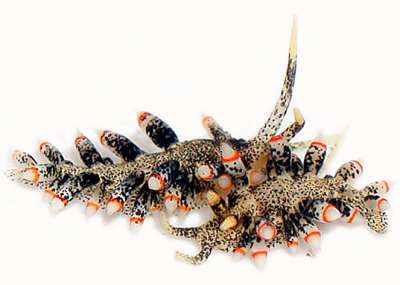
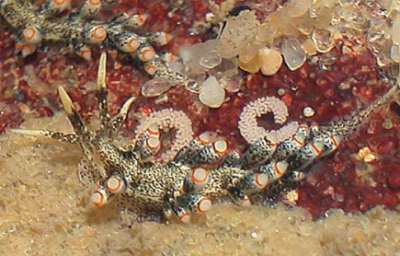
Hi Bill and everyone!
Concerning your comments on my earlier message [#14846]:
After finding the Herviella the other day I got excited and went back to search for more. Sure enough I found 6 more. They ranged from 6 mm to 10 mm and there were lots of egg masses.
Locality: Alexandra Headland, sthn Queensland, Australia. Intertidal. Length: 6-10 mm. 28 September 2005. Photographer: Gary Cobb
I noticed that this species is variable in its colouration. Some appear to have a black band under the whiteish tips of the rhinophores while some do not. After your email the other day, can you tell me this species I am find here on the Sunshine Coast is still H. claror. Denis Riek of Brunswick Heads NSW found one too and his looks the same as mine look the same. Hummm...
Thanks,
Gary Cobb
gary@cobb.com.au
Cobb, G., 2005 (Oct 8) Herviella found again in southern Queensland. [Message in] Sea Slug Forum. Australian Museum, Sydney. Available from http://www.seaslugforum.net/find/14869
Dear Gary,
Welcome to the world of taxonomy. As I said in my earlier comments it is possible that H. affinis and H. claror are colour variants of one species, so your photos could be very useful. These photos, and your accompanying close-ups [#14886], certainly show a blackish band halfway up the rhinophores. Externall then the biggest difference from H. affinis are the lack of a clear white band below the orange ring on the cerata. What we need is more observations of colour variability here and in Japan, and a relook at the radular morphology of both species and others in the genus with an SEM.
I'll continue to use H. claror for your animals, as they come from almost the type locality of the species, but I would not be surprised if it turns out to be the same as Herviella affinis.
Best wishes,
Bill Rudman
Herviella close-ups
October 8, 2005
From: Gary Cobb
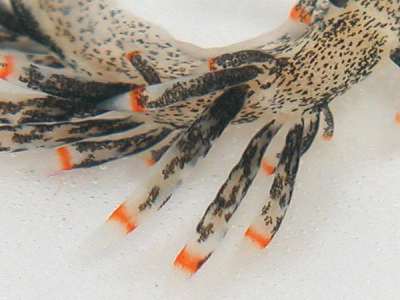
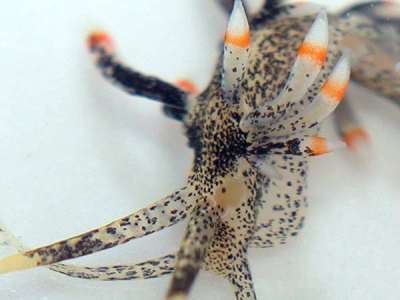
Hi Bill,
Just in case you might need closer inspection of the rhinophores of the Herviella I found intertidally here on the Sunshine Coast, [#14869 ] I have sent you three photos. Does the close-up of the rhinophores reveal black bands...I don't think so. Just a more packed area of black blotches.
It is interesting the little clear area where the eye spots sit.
Locality: Alexandra Headland, sthn Queensland, Australia. Intertidal. Length: 6-10 mm. 29 September 2005. Photographer: Gary Cobb
Cheers
Gary Cobb
gary@cobb.com.au
Cobb, G., 2005 (Oct 8) Herviella close-ups. [Message in] Sea Slug Forum. Australian Museum, Sydney. Available from http://www.seaslugforum.net/find/14886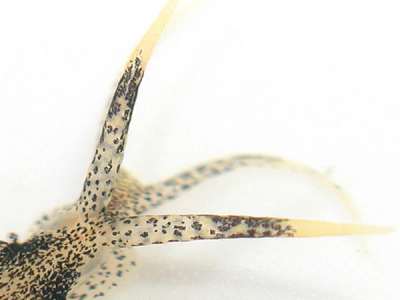
Dear Gary,
Thanks for these. As I comment in your accompanying message [#14869], these almost ceratinly are what Bob Burn described as Herviella claror but whether it is really distinct from H. affinis will require a bit more work.
Best wishes,
Bill Rudman
Herviella found in southern Queensland
September 28, 2005
From: Gary Cobb

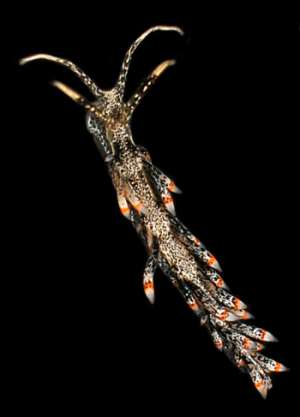
Hi Bill and readers,
Please find attached some pics of Herviella affinis I found under a rock at Alexandra Headland intertidal. It appeared that this animal has faint yellow almost cream tentacles instead of yellow. There were also 3 egg masses. This is what drew my eye to the animal.
Locality: Alexandra Headland, Mooloolaba, Queensland, Australia. intertidal, Length: 12 mm. 26 Septemeber 2005. Intertidal. Photographer: Gary Cobb
This addition has made our species list here on the Sunshine Coast 215. All the species can be viewed at www.nudibranch.com.au
Cheers,
Gary Cobb
gary@nudibranch.com.au
Cobb, G., 2005 (Sep 28) Herviella found in southern Queensland. [Message in] Sea Slug Forum. Australian Museum, Sydney. Available from http://www.seaslugforum.net/find/14846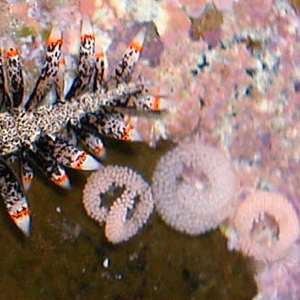
Dear Gary,
This is a nice find, but it is Herviella claror not H. affinis. This species was described by Bob Burn from northern New South Wales, and if you compare it with the photos of H. affinis on the Forum, there are some colour differences. For example H. affinis has a distinct blackish band midway up the rhinophores, and the cerata have black speckling in the lower half to one third, followed by a broad white band below the subterminal orange band. It is possible that these two species and Herviella cloaca and a couple of other species will turn out to be colour variants of one species, but they need to be revised. Unfortunately their small size means they are not often collected, so there is little material available for examination. There are radular differences as well, but the descriptions all predate scanning electron microscopes, so our understanding of radular differences in the genus are based on old light microscopes mounts and drawings.
It's good to get a photo of the egg masses, but unfortunately in this case, the egg masses are so similar to those of H. affinis, that they don't give us any help in deciding if we are dealing with one variable species or a number of similar, but distinct, species.
Best wishes,
Bill Rudman
